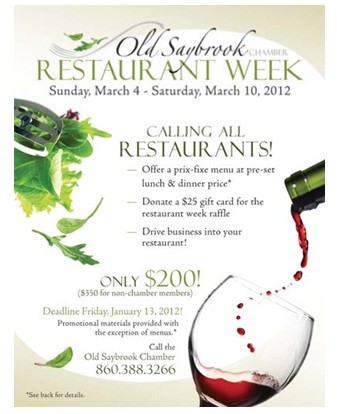Restaurant weeks in small markets? Two media groups show how to do it on a shoe string budget
Shore Publishing makes $20,000 Incremental Revenue in first two markets; and Folsom Telegraph shares their high end strategy
From San Diego to New York City, every large market has a resturant week promotion. However many small markets are also launching this event which is relatively easy to produce and ideal for a small media staff to take on.
Unlike a "Taste of" event in a conference center, Restaurant Week leverages the community. Media promoters do not have to pay for and staff a venue and restaurants are happy to have the foot traffic inside their own establishments. Civic organizations will also help sell and co-promote because the week is perceived as a community service that strengthens economic development.
There are also side benefits: The media builds good will with the restaurant community, shows restaurants the power of the media's advertising, and develops a "foot in the door" with restaurants for longer term marketing relationships.
Below are two case studies of small newspapers whose first restaurant week was well worth the effort; how they created the week on a shoe string, and how it fits into their longer term strategy. Included is a check list for launching an restaurant week in your market.
Company: Shore Publishing
Contributing executive: Robyn Collins, Advertising Director
Initiative: Branford and Old Saybrook Restaurant Weeks
Shoreline publishes 15 weekly newspapers on the Connecticut shoreline from East Haven to Essex with a combined circulation of 122,000. With so many communities to choose from, the team decided focus on the two towns with the most restaurants, Brandford and Old Saybrook to launch its first restaurant weeks promotion.
“Most restaurants in our area are very sporadic in their marketing, tend to just market during the holidays. But Restaurant Week became our gateway to show what marketing through our papers could really do for them,” said Collins.
They decided on a Sunday through Saturday restaurant week in the middle of summer for each of two areas and to allow either lunch or dinner, with lunches at $16 and dinners $25, below the typical 'city" rates of $20 for lunch and $30 for dinner, or more in some large cities. Prix-fixe menus were suggested, though not required, for the events, displayed via hyperlink from the Restaurant Week website.
Likewise the cost to restaurants was a modest $200. Restaurants were required to provide three courses, a substantial discount, and to submit their menu to the newspaper prior to the event, with approval by committee. Because of the small size of the markets with many informal dining areas, diner participants were walk-in traffic, with reservations encouraged at the fine dining spots, though not required.
A wide variety of restaurants participated – delicattesens, cafes, pizza parlors and fine dining.
“The offers varied considerably,” said Collins. “One pizza restaurant offered a salad, pizza for two and a bottle of wine. A fine dining restaurant typically offered an appetizer, entrée and dessert.”
Promotions: Key to promotions was a website for each event that showed pricing and the menus available at each restaurant. Since there were a small number of restaurants, all could be featured prominently on the front of the site:
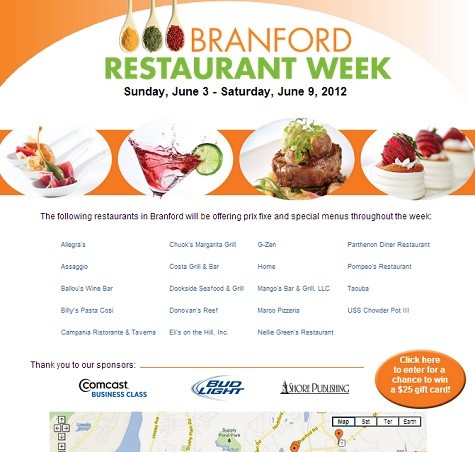
Shore handled all Web and print marketing, including posters, sales flyers for each restaurant (see top right image), a web site and billboards.
Each restaurant also provided a $25 gift card, which were given out in online pre-event contests.
Sales: Partnerships with local groups were critical; the Old Saybrook Chamber of Commerce helped promote participation by Chamber-member restaurants. The Chamber collected the restaurant payments and then charged Shore for the marketing.
Branford partnered with the Town of Branford’s Economic Development Department helped promote restaurant and sponsor participation, helped with marketing meetings and took in all the collections, and paid the marketing bills.
“For both events we and the Chamber and Economic Development folks acted as a ‘promotion couple.’ We didn’t have the staff to pull it all off on our own,” Shore Publishing advertising director Robyn Collins told Local Media Insider. “In both cases, they just really wanted to spearhead this thing.”
Reps at the newspapers within a 25-mile radius of each publication were assigned outside sales goals for acquiring restaurant participants. Sponsorships were also sold at $1500 each. Sponsors included Comcast, the local Webster Bank, Old Saybrook Inn and Spa, and Budweiser.
Results:
• 17 restaurants participated in Saybrook; 19 participated in Bradford. A wide variety of restaurants participated – delis, cafes, pizza parlors and fine dining.
“The offers varied considerably,” said Collins. “One pizza restaurant offered a salad, pizza for two and a bottle of wine. A fine dining restaurant typically offered an appetizer, entrée and dessert.”
• The company took in nearly $10,000 profit for each week, $20,000 total
• Several participating restaurants had never advertised with Shore prior to the event
• Several sporadic advertisers increased the regularity of their newspaper ads after the event
• A post-event survey of participating restaurants determined that 70 percent of them would want to repeat the event if the cost to them remained the same
• Shore plans to add two additional cities, for a total of four Restaurant Weeks
• A post-week survey of restaurants showed that 20 percent of restaurants said that any traffic came from billboards, all said that word of mouth drove the increase in traffic, and three out of four said that newspaper ads brought people in.
SMALL MARKET CASE STUDY 2
Company: Folsom Telegraph, Gold Country Media, owned by Brehm Communications
Key executives: Steve Hollywood, Online Sales Manager; K.T. Flynn, Interactive Specialist
Initiative: Folsom Lake Restaurant Week
Placer, El Dorado and Sacramento Counties in Northern California boast a combined 85,000 households and are home to a variety of mid to high end restaurants that typically did not advertise in the main newspaper, The Folsom Telegraph. The paper decided to launch a restaurant week to position itself within that community. One of Folsom's interactive specialists had already seen San Diego's Restuarant Week. "I was at The San Diego Union-Tribune when they did their restaurant week, and it worked very well,” Katy Flynn, said. “We decided to use their model to create a unique restaurant destination site” for a restaurant week with a local flair.
The initiative had three objectives:
1. To generate advertising revenue from fine-dining restaurants who had never advertised with the Folsom Telegraph
2. Turn sporadic mid-scale restaurant advertisers into consistent ones
3. To create a franchise event that could be repeated five times each year
The event and web were aimed at the higher end of the local market and included nine-days of discount dining options at 20+ upscale and midscale restaurants in the mostly affluent Folsom Lake area.
Restaurants were required to offer a prix fix menu, at $19 or $29. Discounts were approximately 50 percent of the usual meal price. Restaurants paid $225 to participate, for which they were promoted on the event website and all event advertising. Chamber of Commerce members paid a discounted rate of $195.
Restaurants had their name and logo as a participage on the home page of FolsomRestaurantWeek.com, as well as a page with further information including maps and menus:
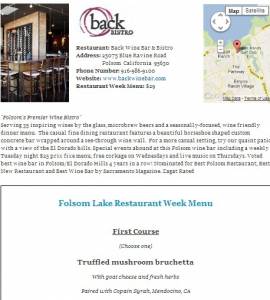
The media pitched in to produce the printed prix fix menus for the restaurants used during the event and delivered weeks earlier; which also ensured that restaurants were prepared to serve the meals they promised. Customers did not have to make reservations – they could just show up at the restaurant of their choice.
Sales: To launch the sales drive, the sales team sent prospective merchants a flier with a sign-up form and complete with details of the benefits, the marketing, process and pricing with contacts:
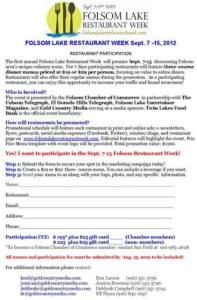
All sales reps participated in the restaurant sales drive. The local Folsom Chamber of Commerce also helped promote the event to its restaurant members, offering a significant discount from the open rate for the event.
Promotions:
The main advertising was newspaper ads, driving residents to FolsomLakeRestaurantWeek.com showcased sponsors and participating restaurants.
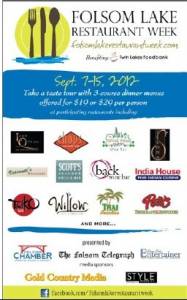
Like Shoreline, each restaurant contributed a $25 gift card as part of a promotional contest. The local Twin Lakes Food Bank received a monetary donation from Gold Country Media for every restaurant that participated. And a Folsom Week Facebook page kept a running dialogue of announcements:
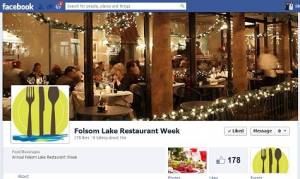
Sacremento Magazine ran a full page ad in trade for advertising. Radio stations did promotional giveaways for gift cards. And local morning radio show hosts from, Good Day, Sacramento, came to two restaurants and walked from one to another, as the event was happening:
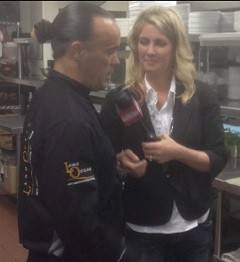
“They actually went back into their kitchens and did the show.” Hollywood said.
After the event the website continues to provide SEO for local restaurants involved, while the home page promotes next year's event:
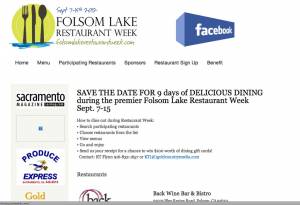
Results:
• Several of the new restaurants have since advertised with Gold Country Media’s weekly paper, the Folsom Telegraph
• The project netted nearly $7000 profit with 21 particpating resturants
• Restaurants realized 10-15 percent increase in customers that week
• Most participating restaurants are taking part in 2013's restaurant week
Restaurant Week Checklist
Here is a summary of take aways to use for launching a restaurant week in a local market. Give these to the team to "cover the bases:"
__ Project manager to oversee the event
__Find the a condensed area of restuarant to focus on and identify if event will be low, mid, high range for branding and pricing
__Partner with a Chamber, Restaurant Association or Development Authority
__Look for other media who will trade or co-promote including live broadcasts from radio at participating restaurants
__Minimum of 15 restaurants
__Web site with a natural URL specific to event, live with "secure the date" for next year. Make sure to post menus online.
__Longer term sales strategy, ie additional package
__Control over the menu: Set the pricing at a flat fee, with 50% discount and approval process
__ Make sure the pricing is in the forefront of promotions so diners know exactly what they get out of it
__Require submission of menu weeks ahead of event and print the menu for them
__Cost to restaurants includes a $25 gift certificate to be used for promotions, including giveawways on radio or package together as one big giveaway
__Create a Facebook page and posting strategy
__In smaller restaurant markets, walk-in traffic, no reservations required
__Post-event survey of participating restaurants. Useful for next year, and also for testimonials
__One sheet to restaurant with all the information (also posted on the website).
__Include customer tracking details in the one sheet/web site adn onboarding meeting. That is, how restuarants will track new diner.
__Consider a per-dinner donation to a well-known local charity
Many thanks to these two companies for showing "how to" create a small market restaurant week.

The author, Alisa Cromer is publisher of a variety of online media, including LocalMediaInsider and MediaExecsTech, developed while on a fellowship with the Reynolds Journalism Institute and which has evolved into a leading marketing company for media technology start-ups. In 2017 she founded Worldstir.com, an online magazine, to showcases perspectives from around the world on new topic each month, translated from and to the top five languages in the world.

